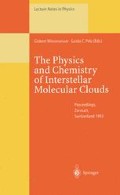Abstract
Molecular gas is the raw material for star formation and hence a crucial factor in galactic evolution. Ultraluminous infrared galaxies emit the bulk of their power in the far infrared, show disturbed morphologies indicative of recent mergers, and rival QSOs in their bolometric luminosities, but are more numerous in the local universe. Although they are as rich in molecular gas as the most gas rich normal spiral galaxies, they have elevated ratios of infrared luminosity to molecular mass that suggest they are undergoing bursts of very rapid and efficient star formation. A survey of HCN(1→0) emission from ten ultraluminous and normal galaxies shows far infrared emission correlates better with the amount of dense, n(H2)>104 cm−3, molecular gas than with the total amount of molecular gas. The star formation efficiency appears to depend on the fraction of the molecular gas reservoir at high density.
The galaxy IRAS 10214+4724 at z=2.286 is perhaps the most luminous object in the universe. Observations of its CO(6→5), CO(4→3), and CO(3→2) lines indicate this galaxy has as much molecular gas as the total mass of the Milky Way. The molecular gas in 10214+4724 is both warmer and denser than that in the Galaxy and the normal gas to dust ratio suggests the abundances are nearly Solar. In the Milky Way, CO (6→5) is only observed in regions of high-mass star formation, so its presence in 10214+4724 implies the occurance of active star formation there. A map of the CO(3→2) emission with 2.3″ resolution shows a small source slightly extended EW with a deconvolved size of (10×4)±4h −1 kpc. The mass of molecular gas is comparable to the dynamical mass. This extraordinary primeval galaxy appears to have most of its mass in molecular gas and to be undergoing an extreme starburst that is generating metals with close to Solar abundances.
Preview
Unable to display preview. Download preview PDF.
References
Brown, R. L., & Vanden Bout, P. A. 1991, AJ 102 1956
Brown, R. L., & Vanden Bout, P. A. 1992, ApJ 397, L11
Brown, R. L., & Vanden Bout, P. A. 1992, ApJ 397, L19
Brown, R. L., Vanden Bout, P. A., & Wooten, H. A. 1993, private communication
Casoli, F., Gerin, M., Encrenaz, P. J., & Combes, F. 1994, A&A, submitted Clements, D. L., et al. 1992, MNRAS 256, 35P.
Clements, D. L., et al. 1993, MNRAS in press
Downes, D., et al. 1992, ApJ 398 L25
Encrenaz P. J., et al. 1993, A&A, 273, L19.
Jaffe, D. T., et al. 1989, ApJ 344, 265.
Kawabe, R., Sakamoto, K., Ishizuki, S., & Ishiguro, M. 1992, ApJ 397, L23
Lawrence, A. et al. 1992, MNRAS 260, 28
Melnick J., & Mirabel, I. F. 1990, A&A 231, L19
Radford, S. J. E., Brown, R. L., & Vanden Bout, P. A. 1993, A&A 271, L71
Rowan-Robinson, M. et al. 1991, Nature 351, 719
Sanders, D. B., et al. 1986, ApJ 305, L45
Sanders, D. B., et al. 1988, ApJ 325, 74.
Sakamoto K., Ishizuki, S., Kawabe, R., Ishiguro, M. 1992, ApJ 397, L27
Soifer, B. T., et al. 1992, ApJ 399, L55
Solomon, P. M., Downes, D., & Radford, S. J. E. 1992, ApJ 387, L55
Solomon, P. M., Downes, D., & Radford, S. J. E. 1992, ApJ 398, L29
Solomon, P. M., Radford, S. J. E. & Downes, D. 1992, Nature 356, 318
Solomon, P. M., & Sage, L. J. 1988, ApJ 334, 613
Tsuboi, M., & Nakai, N. 1992, PASJ 44, L241
Weinberg, S. 1972, Gravitation and Cosmology (Wiley: New York)
Author information
Authors and Affiliations
Editor information
Rights and permissions
Copyright information
© 1995 Springer-Verlag
About this paper
Cite this paper
Radford, S.J.E. (1995). Dense molecular gas in ultraluminous and high redshift galaxies. In: Winnewisser, G., Pelz, G.C. (eds) The Physics and Chemistry of Interstellar Molecular Clouds. Lecture Notes in Physics, vol 459. Springer, Berlin, Heidelberg. https://doi.org/10.1007/BFb0102093
Download citation
DOI: https://doi.org/10.1007/BFb0102093
Published:
Publisher Name: Springer, Berlin, Heidelberg
Print ISBN: 978-3-540-60482-2
Online ISBN: 978-3-540-47665-8
eBook Packages: Springer Book Archive

